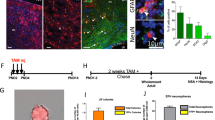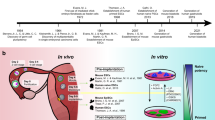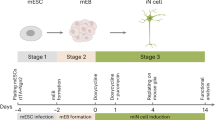Abstract
The discovery of stem cells that can generate neural tissue has raised new possibilities for repairing the nervous system. A rush of papers proclaiming adult stem cell plasticity has fostered the notion that there is essentially one stem cell type that, with the right impetus, can create whatever progeny our heart, liver or other vital organ desires. But studies aimed at understanding the role of stem cells during development have led to a different view — that stem cells are restricted regionally and temporally, and thus not all stem cells are equivalent. Can these views be reconciled?
This is a preview of subscription content, access via your institution
Access options
Subscribe to this journal
Receive 51 print issues and online access
$199.00 per year
only $3.90 per issue
Buy this article
- Purchase on Springer Link
- Instant access to full article PDF
Prices may be subject to local taxes which are calculated during checkout




Similar content being viewed by others
References
Temple, S. Division and differentiation of isolated CNS blast cells in microculture. Nature 340, 471–473 (1989).
Cattaneo, E. & McKay, R. Proliferation and differentiation of neuronal stem cells regulated by nerve growth factor. Nature 347, 762–765 (1990).
Reynolds, B. A., Tetzlaff, W. & Weiss, S. A multipotent EGF-responsive striatal embryonic progenitor cell produces neurons and astrocytes. J. Neurosci. 12, 4565–4574 (1992).
Kilpatrick, T. J. & Bartlett, P. F. Cloning and growth of multipotential neural precursors: requirements for proliferation and differentiation. Neuron 10, 255–265 (1993).
Stemple, D. L. & Anderson, D. J. Isolation of a stem cell for neurons and glia from the mammalian neural crest. Cell 71, 973–985 (1992).
Reynolds, B. A. & Weiss, S. Generation of neurons and astrocytes from isolated cells of the adult mammalian central nervous system. Science 255, 1707–1710 (1992).
Lois, C. & Alvarez-Buylla, A. Proliferating subventricular zone cells in the adult mammalian forebrain can differentiate into neurons and glia. Proc. Natl Acad. Sci. USA 90, 2074–2077 (1993).
McKay, R. Stem cells in the central nervous system. Science 276, 66–71 (1997).
Rao, M. S. Multipotent and restricted precursors in the central nervous system. Anat. Rec. 257, 137–148 (1999).
Gage, F. H. Mammalian neural stem cells. Science 287, 1433–1438 (2000).
Capela, A. & Temple, S. A putative surface marker for adult mouse neural stem cells. Soc. Neurosci. Abstr. 24.19 〈http://sfn.scholarone.com/itin2000/〉 (2000).
Kawaguchi, A. et al. Nestin-EGFP transgenic mice: visualization of the self-renewal and multipotency of CNS stem cells. Mol. Cell. Neurosci. 17, 259–273 (2001).
Uchida, N. et al. Direct isolation of human central nervous system stem cells. Proc. Natl Acad. Sci. USA 97, 14720–14725 (2000).
Rietze, R. L. et al. Purification of a pluripotent neural stem cell from the adult mouse brain. Nature 412, 736–739 (2001).
Anderson, D. J. et al. Cell lineage determination and the control of neuronal identity in the neural crest. Cold Spring Harb. Symp. Quant. Biol. 62, 493–504 (1997).
Kalyani, A., Hobson, K. & Rao, M. S. Neuroepithelial stem cells from the embryonic spinal cord: isolation, characterization, and clonal analysis. Dev. Biol. 186, 202–223 (1997).
Kalyani, A. J., Piper, D., Mujtaba, T., Lucero, M. T. & Rao, M. S. Spinal cord neuronal precursors generate multiple neuronal phenotypes in culture. J. Neurosci. 18, 7856–7868 (1998).
Qian, X. et al. Timing of CNS cell generation: a programmed sequence of neuron and glial cell production from isolated murine cortical stem cells. Neuron 28, 69–80 (2000).
He, W., Ingraham, C., Rising, L., Goderie, S. & Temple, S. Multipotent stem cells from the mouse basal forebrain contribute GABAergic neurons and oligodendrocytes to the cerebral cortex during embryogenesis. J. Neurosci. (in the press).
White, P. M. et al. Neural crest stem cells undergo cell-intrinsic developmental changes in sensitivity to instructive differentiation signals. Neuron 29, 57–71 (2001).
Tropepe, V. et al. Distinct neural stem cells proliferate in response to EGF and FGF in the developing mouse telencephalon. Dev. Biol. 208, 166–188 (1999).
Tropepe, V. et al. Direct neural fate specification from embryonic stem cells. A primitive mammalian neural stem cell stage acquired through a default mechanism. Neuron 30, 65–78 (2001).
Wolpert, L. Positional information and pattern formation in development. Dev. Genet. 15, 485–490 (1994).
Altmann, C. R. & Brivanlou, A. H. Neural patterning in the vertebrate embryo. Int. Rev. Cytol. 203, 447–482 (2001).
Skeath, J. B. At the nexus between pattern formation and cell-type specification: the generation of individual neuroblast fates in the Drosophila embryonic central nervous system. BioEssays 21, 922–931 (1999).
Tropepe, V., Hitoshi, S., Ekker, M. & van der Kooy, D. Neural stem cells and their progeny express region-specific gene in the developing CNS, but this expression is not irreversible and can be altered by local inductive cues. Soc. Neurosci. Abstr. 23.1 〈http://sfn.scholarone.com/itin2000/〉 (2000).
Zappone, M. V. et al. Sox2 regulatory sequences direct expression of a β-geo transgene to telencephalic neural stem cells and precursors of the mouse embryo, revealing regionalization of gene expression in CNS stem cells. Development 127, 2367–2382 (2000).
Mujtaba, T., Mayer-Proschel, M. & Rao, M. S. A common neural progenitor for the CNS and PNS. Dev. Biol. 200, 1–15 (1998).
Desai, A. R. & McConnell, S. K. Progressive restriction in fate potential by neural progenitors during cerebral cortical development. Development 127, 2863–2872 (2000).
Barbe, M. F. & Levitt, P. The early commitment of fetal neurons to the limbic cortex. J. Neurosci. 11, 519–533 (1991).
Olsson, M., Campbell, K. & Turnbull, D. H. Specification of mouse telencephalic and mid-hindbrain progenitors following heterotopic ultrasound-guided embryonic transplantation. Neuron 19, 761–772 (1997).
Lim, D. A., Fishell, G. J. & Alvarez-Buylla, A. Postnatal mouse subventricular zone neuronal precursors can migrate and differentiate within multiple levels of the developing neuraxis. Proc. Natl Acad. Sci. USA 94, 14832–14836 (1997).
Alvarez-Buylla, A., Herrera, D. G. & Wichterle, H. The subventricular zone: source of neuronal precursors for brain repair. Prog. Brain Res. 127, 1–11 (2000).
Reh, T. A. & Levine, E. M. Multipotential stem cells and progenitors in the vertebrate retina. J. Neurobiol. 36, 206–220 (1998).
Livesey, F. J. & Cepko, C. L. Vertebrate neural cell-fate determination: lessons from the retina. Nature Rev. Neurosci. 2, 109–118 (2001).
Alvarez-Buylla, A., Garcia-Verdugo, J. M. & Tramontin, A. D. A unified hypothesis on the lineage of neural stem cells. Nature Rev. Neurosci. 2, 287–293 (2001).
Doetsch, F., Caille, I., Lim, D. A., Garcia-Verdugo, J. M. & Alvarez-Buylla, A. Subventricular zone astrocytes are neural stem cells in the adult mammalian brain. Cell 97, 703–716 (1999).
Shen, Q., Qian, X., Capela, A. & Temple, S. Stem cells in the embryonic cerebral cortex: their role in histogenesis and patterning. J. Neurobiol. 36, 162–174 (1998).
Brody, T. & Odenwald, W. F. Programmed transformations in neuroblast gene expression during Drosophila CNS lineage development. Dev. Biol. 226, 34–44 (2000).
Isshiki, T., Pearson, B., Holbrook, S. & Doe, C. Q. Drosophila neuroblasts sequentially express transcription factors which specify the temporal identity of their neuronal progeny. Cell 106, 511–521 (2001).
Shihabuddin, L. S., Horner, P. J., Ray, J. & Gage, F. H. Adult spinal cord stem cells generate neurons after transplantation in the adult dentate gyrus. J. Neurosci. 20, 8727–8735 (2000).
Suhonen, J. O., Peterson, D. A., Ray, J. & Gage, F. H. Differentiation of adult hippocampus-derived progenitors into olfactory neurons in vivo. Nature 383, 624–627 (1996).
Weissman, I. L. Stem cells: units of development, units of regeneration, and units in evolution. Cell 100, 157–168 (2000).
Anderson, D. J. Stem cells and pattern formation in the nervous system. The possible versus the actual. Neuron 30, 19–35 (2001).
Temple, S. Stem cell plasticity—building the brain of our dreams. Nature Neurosci. Rev. 2, 513–520 (2001).
Durbec, P. & Rougon, G. Transplantation of mammalian olfactory progenitors into chick hosts reveals migration and differentiation potentials dependent on cell commitment. Mol. Cell. Neurosci. 17, 561–576 (2001).
Kondo, T. & Raff, M. Oligodendrocyte precursor cells reprogrammed to become multipotential CNS stem cells. Science 289, 1754–1757 (2000).
Doetsch, F. K., Caille, I., Garcia-Verdugo, J. M. & Alvarez-Buylla, A. EGF induces conversion of transit amplifying neurogenic precursors into multipotential invasive cells in the adult brain. Soc. Neurosci. Abstr. 894.4 〈http://sfn.scholarone.com/itin2001/〉 (2001).
Fischer, A. J. & Reh, T. A. Muller glia are a potential source of neural regeneration in the postnatal chicken retina. Nature Neurosci. 4, 247–252 (2001).
Goldowitz, D. Cell allocation in mammalian CNS formation: evidence from murine interspecies aggregation chimeras. Neuron 3, 705–713 (1989).
Tan, S. S. et al. Separate progenitors for radial and tangential cell dispersion during development of the cerebral neocortex. Neuron 21, 295–304 (1998).
Brustle, O. et al. In vitro-generated neural precursors participate in mammalian brain development. Proc. Natl Acad. Sci. USA 94, 14809–14814 (1997).
Winkler, C. et al. Incorporation and glial differentiation of mouse EGF-responsive neural progenitor cells after transplantation into the embryonic rat brain. Mol. Cell. Neurosci. 11, 99–116 (1998).
Brustle, O. et al. Chimeric brains generated by intraventricular transplantation of fetal human brain cells into embryonic rats. Nature Biotechnol. 16, 1040–1044 (1998).
Flax, J. D. et al. Engraftable human neural stem cells respond to developmental cues, replace neurons, and express foreign genes. Nature Biotechnol. 16, 1033–1039 (1998).
Brustle, O., Maskos, U. & McKay, R. D. Host-guided migration allows targeted introduction of neurons into the embryonic brain. Neuron 15, 1275–1285 (1995).
Campbell, K., Olsson, M. & Bjorklund, A. Regional incorporation and site-specific differentiation of striatal precursors transplanted to the embryonic forebrain ventricle. Neuron 15, 1259–1273 (1995).
Betarbet, R., Zigova, T., Bakay, R. A. & Luskin, M. B. Migration patterns of neonatal subventricular zone progenitor cells transplanted into the neonatal striatum. Cell Transplant. 5, 165–178 (1996).
Lois, C. & Alvarez-Buylla, A. Long-distance neuronal migration in the adult mammalian brain. Science 264, 1145–1148 (1994).
Clarke, D. L. et al. Generalized potential of adult neural stem cells. Science 288, 1660–1663 (2000).
Herrera, D. G., Garcia-Verdugo, J. M. & Alvarez-Buylla, A. Adult-derived neural precursors transplanted into multiple regions in the adult brain. Ann. Neurol. 46, 867–877 (1999).
Gage, F. H. et al. Survival and differentiation of adult neuronal progenitor cells transplanted to the adult brain. Proc. Natl Acad. Sci. USA 92, 11879–11883 (1995).
Pagano, S. F. et al. Isolation and characterization of neural stem cells from the adult human olfactory bulb. Stem Cells 18, 295–300 (2000).
Tropepe, V. et al. Retinal stem cells in the adult mammalian eye. Science 287, 2032–2036 (2000).
Laywell, E. D., Rakic, P., Kukekov, V. G., Holland, E. C. & Steindler, D. A. Identification of a multipotent astrocytic stem cell in the immature and adult mouse brain. Proc. Natl Acad. Sci. USA 97, 13883–13888 (2000).
Zhu, G., Mehler, M. F., Mabie, P. C. & Kessler, J. A. Developmental changes in progenitor cell responsiveness to cytokines. J. Neurosci. Res. 56, 131–145 (1999).
Gritti, A. et al. Epidermal and fibroblast growth factors behave as mitogenic regulators for a single multipotent stem cell-like population from the subventricular region of the adult mouse forebrain. J. Neurosci. 19, 3287–3297 (1999).
Burrows, R. C., Wancio, D., Levitt, P. & Lillien, L. Response diversity and the timing of progenitor cell maturation are regulated by developmental changes in EGFR expression in the cortex. Neuron 19, 251–267 (1997).
Lillien, L. & Raphael, H. BMP and FGF regulate the development of EGF-responsive neural progenitor cells. Development 127, 4993–5005 (2000).
Qian, X., Davis, A. A., Goderie, S. K. & Temple, S. FGF2 concentration regulates the generation of neurons and glia from multipotent cortical stem cells. Neuron 18, 81–93 (1997).
Li, W., Cogswell, C. A. & LoTurco, J. J. Neuronal differentiation of precursors in the neocortical ventricular zone is triggered by BMP. J. Neurosci. 18, 8853–8862 (1998).
Li, W. & LoTurco, J. J. Noggin is a negative regulator of neuronal differentiation in developing neocortex. Dev. Neurosci. 22, 68–73 (2000).
Mehler, M. F., Mabie, P. C., Zhu, G., Gokhan, S. & Kessler, J. A. Developmental changes in progenitor cell responsiveness to bone morphogenetic proteins differentially modulate progressive CNS lineage fate. Dev. Neurosci. 22, 74–85 (2000).
Lim, D. A. et al. Noggin antagonizes BMP signaling to create a niche for adult neurogenesis. Neuron 28, 713–726 (2000).
Kirschstein, R. & Skirboll, L. R. Stem Cells: Scientific Progress and Future Research Directions (NIH, Bethesda, 2001).
Acknowledgements
I thank Q. Shen for her help with Table 1 and for invaluable discussions; K. Kirchofer for preparing the manuscript; and S. Dunnett for summarizing the potential therapeutic applications of stem cells in Box 1.
Author information
Authors and Affiliations
Corresponding author
Rights and permissions
About this article
Cite this article
Temple, S. The development of neural stem cells. Nature 414, 112–117 (2001). https://doi.org/10.1038/35102174
Issue Date:
DOI: https://doi.org/10.1038/35102174
This article is cited by
-
Development of synthetic modulator enabling long-term propagation and neurogenesis of human embryonic stem cell-derived neural progenitor cells
Biological Research (2023)
-
Directional induction of neural stem cells, a new therapy for neurodegenerative diseases and ischemic stroke
Cell Death Discovery (2023)
-
Stem Cell Therapy in Spinal Cord Injury-Induced Neurogenic Lower Urinary Tract Dysfunction
Stem Cell Reviews and Reports (2023)
-
Inhibition of Foxp4 Disrupts Cadherin-based Adhesion of Radial Glial Cells, Leading to Abnormal Differentiation and Migration of Cortical Neurons in Mice
Neuroscience Bulletin (2023)
-
The role of neural stem cells in regulating glial scar formation and repair
Cell and Tissue Research (2022)
Comments
By submitting a comment you agree to abide by our Terms and Community Guidelines. If you find something abusive or that does not comply with our terms or guidelines please flag it as inappropriate.



